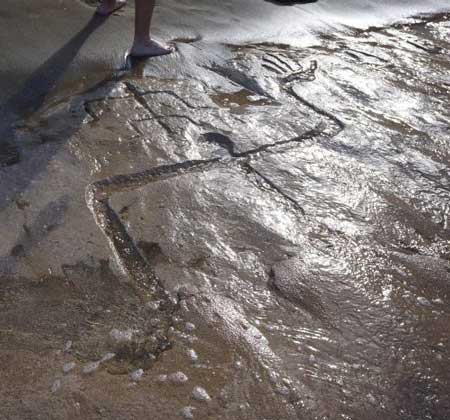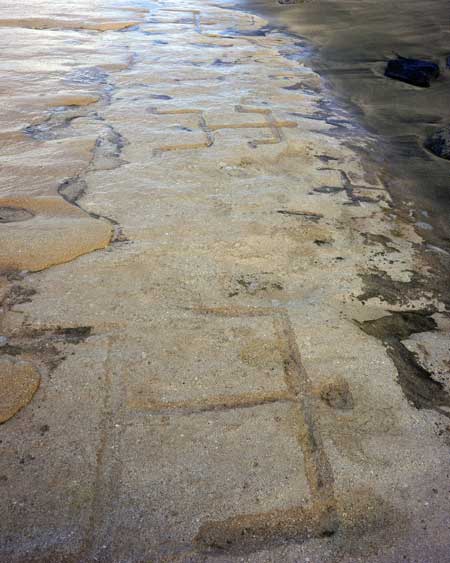“What’s exciting for me is: I grew up coming to this beach, and now as an archaeologist working for the Army, helping to manage this site, we discovered these petroglyphs that have never been recorded,” – Alton Exzabe

PHOTO: westerndigs.org
WAIANAE, HAWAII – This late July, tourists flocked to the beaches to find, at low tide, the bedrock of the western coast of Oahu Island exposed. A surprise awaited them there: across the wet rock figures danced, their feet pointing toward the ocean.
These glyphs have never been discovered before now. They’re carved into the sandstone floor of the beach at Waianae. Usually, the rock is covered in sand, which is why the petroglyphs haven’t been seen until now. Each glyph stands about one foot tall with the largest of them measuring at an impressive five feet.

PHOTO: westerndigs.org
Immediately after the glyphs were reported, the authorities at Waianae called in U.S. Army archaeologist Alton Exzabe to survey the area. Once he had a look around, he said it’s likely the glyphs have probably been exposed before, at some point in history, but this is the first time its ever been recorded by historians.
When the locals were asked about it, they said some of them had definitely seen the glyphs on the beach, but they never reported it.
So far, 17 petroglyphs in all have been discovered and recorded. The markings span across 60 feet of the sandstone beach. Exzabe remarked one one of the glyphs – a life-sized anthropomorphic carving with articulated fingers and toes – was probably the most memorable for him.
“I believe there are some elsewhere [in Hawaii] with fingers, but fingers and hands are pretty distinct, as well as the size of them,” he said, “We find a lot of petroglyphs that are a foot or so tall, but this one measures four to five feet from head to toe. It’s pretty impressive.”
This isn’t the first set of petroglyphs to be exposed by low tides in Hawaii. In 2014, a storm washed away the sands on Oahu’s northern shore at Waimea. In the volcanic rock, tourists and archaeologists could just make out the figures etched there. There were over 70 distinct images, depicting humans and dogs. That art had been recorded by authorities before, but the 2014 storm was the first time it had been seen by anyone in four years.
Understanding the Glyphs
Before any theories as to the exact purpose of these glyphs can be posed, native of Oahu, Glen Kila said, “These petroglyphs can only be interpreted by the lineal descendants who are familiar with its history and culture.”
Glen Kila is a direct descendant of the first people living at Nene’u, an ancient settlement just north of the site at Waianae. He’s adamant that the significance and purpose of the glyphs must come first from the cultural group to whom the glyphs belong.
It’s important to return the knowledge of the glyphs to the native population at Oahu. It’s part of their heritage and history, and it should not be lost. Before archaeologists throw theories out there, they ought to take the time to understand the people that live on the island and what they think about the glyphs.
When asked what his thoughts were, Glen Kila replied: “They record our genealogy and religion.”
Exzabe and his group swooped in on the site to record the glyphs before they’re lost to the sands once again. The glyphs at Waianae are unique, and the newest yet to the archaeological record of Hawaii. The team of archaeologists worked around the clock to document them – and just in time, too. They’re already disappearing once again.
“They are an important part of Hawaii’s culture, and while sands have covered them again, in time they will reappear, and we want to make sure people know that they are fragile and culturally sensitive and should only be viewed, not touched.” – Alan Downer, staff member at Hawaii’s historic preservation office.

